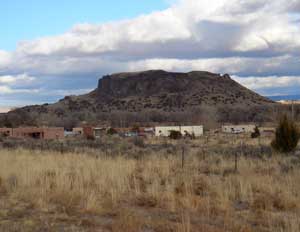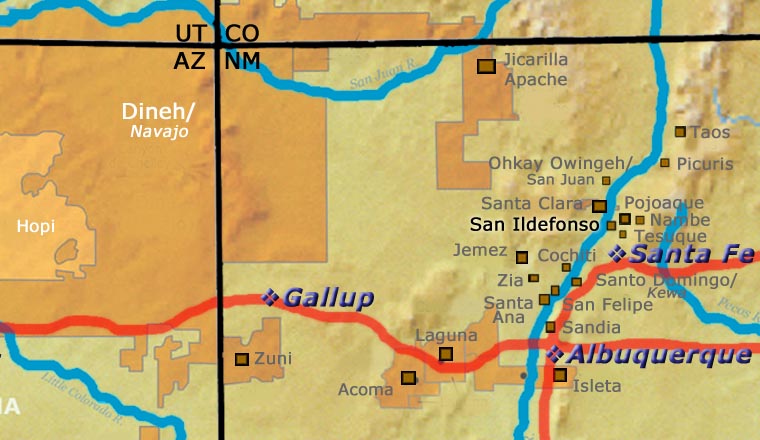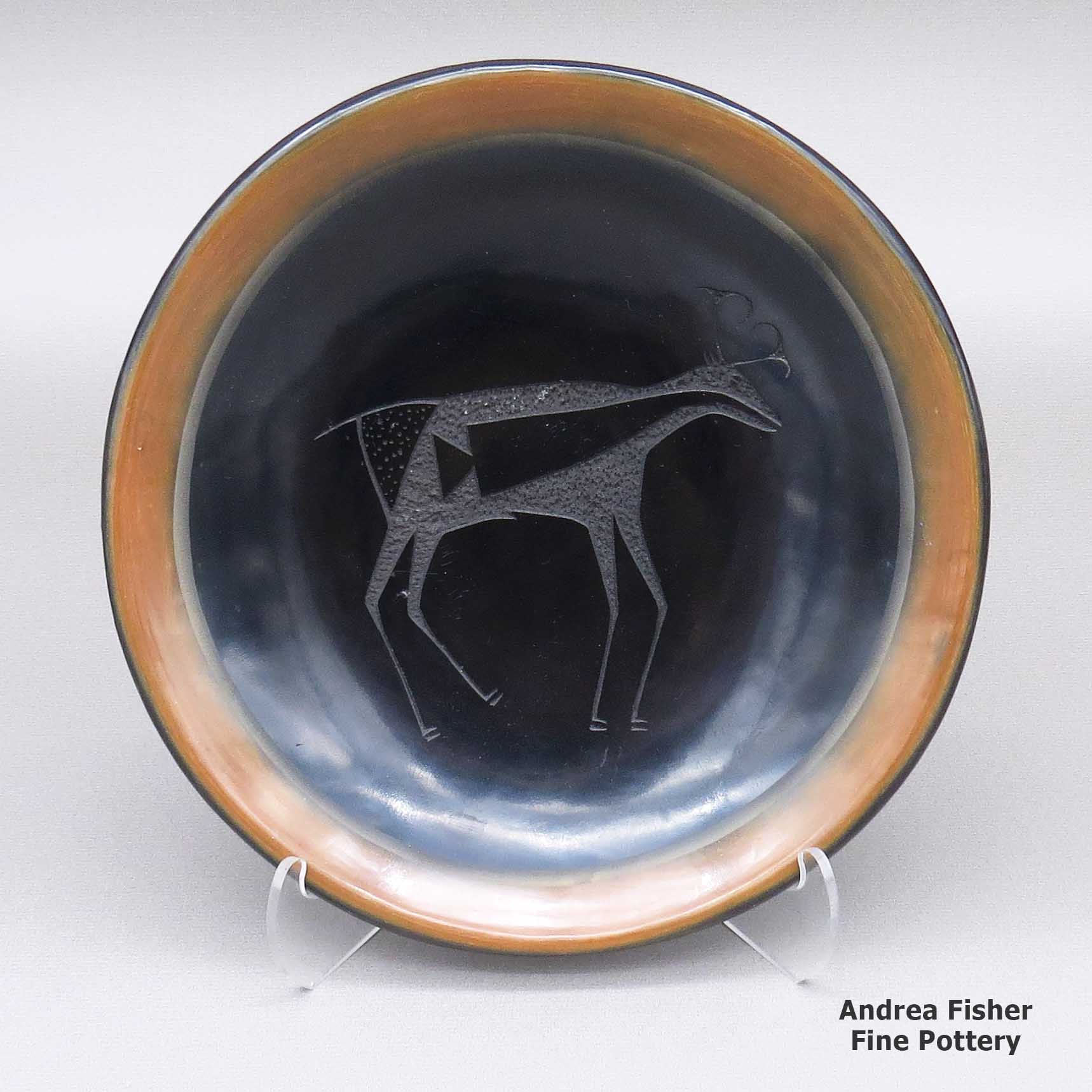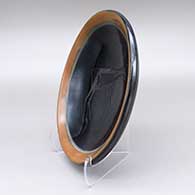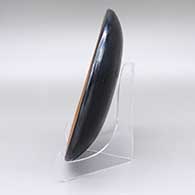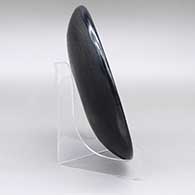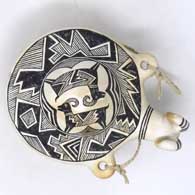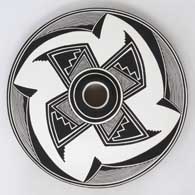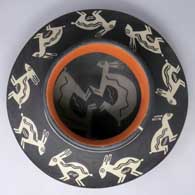
Tony Da
San Ildefonso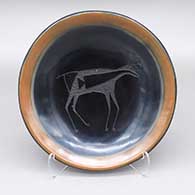
Tony Da (1940-2008) was the son of Popovi Da and grandson of Maria Martinez. He grew up surrounded by some of the finest potters and painters at San Ildefonso Pueblo and his early education emphasized those traditional arts. He lived with his grandmother Maria while his father was in the Army during World War II and she felt great promise in him as an artist. When he started school, though, it was quickly felt that he was most likely dyslexic. After finishing his first eight years in the Pojoaque Valley schools, he moved on to St. Michael's High School in Santa Fe. He was unhappy there and transferred to Santa Fe High where he graduated in 1958. He then attended Western New Mexico College (in Silver City) for a year before joining the US Navy for four years. It was at Western New Mexico that he was exposed to Mimbres pottery and its imagery and that made a life-long impression on him. It was also at Western New Mexico that he was exposed to modern methods of painting and ceramics production.
When he returned to San Ildefonso in 1964 he became fascinated with the pottery that his grandmother and father were creating together. At that time he apprenticed himself to Maria and began learning to make pottery in earnest. His progress was such that three years later his works appeared alongside Maria's and Popovi's in the Three Generations Show at the US Department of the Interior in Washington, DC. In 1967 he also had his first booth at the Gallup InterTribal Ceremonials. He took eight pieces of his art to the show and earned four First Place ribbons and one Second Place ribbon for pottery, two more First Place ribbons in painting and one more in sculpture. One of his paintings and one of his pots also received "Excellent" ribbons.
Tony didn't produce a lot of pottery during his short career and he mainly produced redware, blackware and two-tone bowls, plates, jars, turtles and bears. His favorite designs seem to have been kokopelli, avanyu (water serpent), buffalo, bear and cloud, sometimes painted and sometimes etched (sgraffito).
Tony was able to build something new on the foundation of his family, who had built something new on the foundation of their predecessors. His work has been called inspired and innovative and it has made an enormous impact on modern pueblo ceramics, especially at San Ildefonso and Santa Clara. Tony was the first Pueblo potter to inlay strands of heishi, coral and turquoise beads, often in incised channels around the tall necks of vases. He also painted and incised designs found on ancient Mimbres pottery. In the late 1960s he was developing low relief sgraffito designs. He also became famous for his two-tone pottery bear fetishes, often wrapped and inlaid with channel beading. He participated in the Santa Fe Indian Market between 1967 and 1976, earning several First Place ribbons for his pottery.
In an interview in 1971 Tony said, "If my work is satisfactory to me then I am content. I do it mostly for my own pleasure." He also famously said, "I'm not really influenced by current trends. I do what I like. I learned pottery making from my grandmother but I have never had any lessons in painting. That is all self-taught. I use a lot of drafting in my paintings and the style is the same. A crooked line bothers me. I can't make a crooked line."
On April 15, 1982, Tony had a motorcycle accident on a gravel road that caused a severe brain injury. It didn't end his life but it ended his pottery-making career. He was able to continue painting but his creations were much simpler and didn't have the depth of field of his previous work. Like his father before him, he was a perfectionist and he'd felt he was about to make an extraordinary breakthrough in his work before the accident. Who knows what he might have achieved had he been wearing a helmet that fateful day.
Tony Da's influence has been such that The Life and Art of Tony Da was first published in 2011 and passed through ten printings very quickly. That same year the Museum of Indian Arts and Culture in Santa Fe opened Creative Spark! The Life and Art of Tony Da, the largest and most comprehensive showing ever of Tony Da paintings and pottery. Some of the works shown had never been seen in public before.
Tony's wife Lou died before he did. His son Jarrod Da is a renowned painter who is forging into new areas in Native American painting while Tony's daughter Royale Da is a news anchor with one of the network television stations in Albuquerque.
100 West San Francisco Street, Santa Fe, New Mexico 87501
(505) 986-1234 - www.andreafisherpottery.com - All Rights Reserved

San Ildefonso Pueblo
San Ildefonso Pueblo is located about twenty miles northwest of Santa Fe, New Mexico, mostly on the eastern bank of the Rio Grande. Although their ancestry has been traced to prehistoric pueblos in the Mesa Verde area, their most recent ancestral home is in the area of Bandelier National Monument, the prehistoric village of Tsankawi in particular. Tsankawi abuts the reservation on its northwest side.
A mission church was built in 1617 and named for San Ildefonso. Hence the name. Before that the village was called Powhoge, "where the water cuts through" (in Tewa). Today's pueblo was established as long ago as the 1300s. When the Spanish arrived in 1540, they estimated the village population at about 2,000.
That mission was destroyed during the Pueblo Revolt of 1680 and when Don Diego de Vargas returned to reclaim the San Ildefonso area in 1694, he found virtually all the Tewa people on top of nearby Black Mesa. After an extended siege the two sides negotiated a treaty and the people returned to their villages. However, the next 250 years were not good for them. The Spanish swine flu pandemic of 1918 reduced the pueblo's population to about 90. Their population has grown to more than 600 now but the only economic activity available on the pueblo involves creating art in one form or another. The only other work is off-pueblo. San Ildefonso's population is small compared to neighboring Santa Clara Pueblo, but the pueblo maintains its own religious traditions and ceremonial feast days.
San Ildefonso is most known for being the home of the most famous Pueblo Indian potter, Maria Martinez. Many other excellent potters from this pueblo have produced quality pottery, too, among them: Blue Corn, Tonita and Juan Roybal, Dora Tse Pe and Rose Gonzales. Of course the descendants of Maria Martinez are still important pillars of San Ildefonso's pottery tradition. Maria's influence reached far and wide, so far and wide that even Juan Quezada of the Mata Ortiz pottery renaissance in Chihuahua, Mexico, came to San Ildefonso to learn from her.
100 West San Francisco Street, Santa Fe, New Mexico 87501
(505) 986-1234 - www.andreafisherpottery.com - All Rights Reserved

San Ildefonso
$ CALL
zzsi3b542
Black plate with a sienna rim and a sgraffito Mimbres deer design
6.5 in L by 6.5 in W by 1.25 in H
Condition: Very good, has light scratching on top
Signature: His DA hallmark
100 West San Francisco Street, Santa Fe, New Mexico 87501
(505) 986-1234 - www.andreafisherpottery.com - All Rights Reserved

Mimbres Pottery
Mimbres Mogollon Culture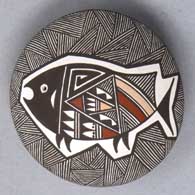
Rebecca Lucario
Acoma

Verda Toledo
Jemez
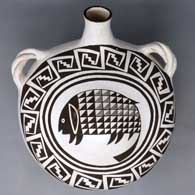
Marie Z. Chino
Acoma
The Mimbres Mogollon culture was named for the Mimbres River in the Gila Mountains. They lived in the area from about 850 CE to about 1150 CE. Substantial depopulation of the area occurred but there were many small surviving populations. Over time, these melted into the surrounding cultures with many families moving north to Acoma, Zuni and Hopi while others moved south to Casas Grande and Paquimé.
The time period from about 850 CE to about 1000 CE is classed the Late Basketmaker III period. The time period was characterized by the evolution of square and rectangular pithouses with plastered floors and walls. Ceremonial structures were generally dug deep into the ground. Local forms of pottery have been classified as early Mimbres black-on-white (formerly Boldface Black-on-White), textured plainware and red-on-cream.
The Classic Mimbres phase (1000 CE to 1150 CE) was marked with the construction of larger buildings in clusters of communities around open plazas. Some constructions had up to 150 rooms. Most groupings of rooms included a ceremonial room, although smaller square or rectangular underground kivas with roof openings were also being used. Classic Mimbres settlements were located in areas with well-watered floodplains available, suitable for the growing of maize, squash and beans. The villages were limited in size by the ability of the local area to grow enough food to support the village.
Pottery produced in the Mimbres region is distinct in style and decoration. Early Mimbres black-on-white pottery was primarily decorated with bold geometric designs, although some early pieces show human and animal figures. Over time the rendering of figurative and geometric designs grew more refined, sophisticated and diverse, suggesting community prosperity and a rich ceremonial life. Classic Mimbres black-on-white pottery is also characterized by bold geometric shapes but done with refined brushwork and very fine linework. Designs may include figures of one or multiple humans, animals or other shapes, bounded by either geometric decorations or by simple rim bands. A common figure on a Mimbres pot is the turkey, another is the thunderbird. There are also a lot of different fish depicted, some are species found in the Gulf of California.
A lot of Mimbres bowls (with kill holes) have been found in archaeological excavations but most Mimbres pottery shows evidence it was actually used in day-to-day life and wasn't produced just for burial purposes.
There's a lot of speculation as to what happened to the Mimbres people as their countryside was rapidly depopulated after about 1150 CE. The people of Isleta, Acoma and Laguna find ancient Mimbres pot shards on their pueblo lands, indicating that pottery designs from the Mimbres River area migrated north. There are similar designs found on pot shards littering the ground around Casas Grandes and Paquime near Mata Ortiz and Nuevo Casas Grandes in northern Mexico. Other than where they went, the only reasons offered for why they left involve at least small scale climate change. The usual comment is "drought" but drought could have been brought on by the eruption of a volcano on the other side of the planet, or a small change in the El Nino-La Nina schedule. Whatever it was that started the outflow of people, it began in the Mimbres River area and spread outward from there. Excavations in the Eastern Mimbres region (nearer to Truth or Consequences, New Mexico) have shown that the people adapted to new circumstances and that adaptation itself moved them closer into alignment with surrounding tribes and cultures. Eventually they just kind of merged into the background, although the groups that moved south and built up Paquime and Casas Grandes seem to have lost a war and survivors migrated to the west, to a land a bit more hospitable for them.
100 West San Francisco Street, Santa Fe, New Mexico 87501
(505) 986-1234 - www.andreafisherpottery.com - All Rights Reserved

Maria Martinez Family Tree
Disclaimer: This "family tree" is a best effort on our part to determine who the potters are in this family and arrange them in a generational order. The general information available is questionable so we have tried to show each of these diagrams to living members of each family to get their input and approval, too. This diagram is subject to change should we get better info.
- Cipriana Peña (c. 1810-)
- Santana Peña (1846-) & Antonio Domingo Peña (1841-)
- Nicolasa Peña Montoya (1863-1904) & Juan Cruz Montoya
- Tonita Martinez Roybal (1892-1945) & Alfredo Montoya
- Isabel Montoya (1898-1996) & Benjamin Atencio
- Angelita Atencio Sanchez (1927-1993) & Santiago Sanchez
- Sandra Sanchez Chaparro
- Gilbert Atencio (1930-1995)
- Tony Atencio (1928-)
- Helen Gutierrez (1935-1993) & Frank Gutierrez (Santa Clara)
- Carol & James Gutierrez
- Kathy Gutierrez Naranjo & Ernest J. Naranjo
- Rose Gutierrez
- Geraldine Gutierrez Shije (1959-)
- Angelita Atencio Sanchez (1927-1993) & Santiago Sanchez
- Rayita Montoya
- Santana Montoya & Antonio Vigil
- Lupita Vigil Martinez (1918-2006) & Anselmo Martinez (1909-1965)
- Reyes Peña (d. 1909) & Tomas Montoya (d. 1914)
- Desideria Montoya (1889-1982)
- Maria Montoya Martinez (1887-1980) & Julian Martinez (1884-1943)
- Adam Martinez (1903-2000) and Santana Roybal Martinez (1909-2002)
- George Martinez (1943-) & Pauline Martinez (Santa Clara)(1950-)
- Adam Martinez
- Jesse Martinez
- Jolene Martinez
- Anita Martinez (d. 1992) & Pino Martinez
- Barbara Tahn-Moo-Whe Gonzales (1947-) & Robert Gonzales
- Aaron Gonzales (1971-)
- Brandon Gonzales (1983-)
- Cavan Gonzales (1970-)
- Derek Gonzales (1986-)
- Kathy Wan Povi Sanchez (1950-) & Gilbert Sanchez
- Corrine Sanchez
- Gilbert Abel Sanchez
- Liana Sanchez
- Wayland Sanchez
- Evelyn Than-Povi Garcia
- Myra Garcia
- Berlinda Garcia
- Myra Garcia
- Peter Pino
- Barbara Tahn-Moo-Whe Gonzales (1947-) & Robert Gonzales
- Viola Martinez/Sunset Cruz & Johnnie Cruz Sr.
- Beverly Martinez (1960-1987)
- Marvin Martinez (1964-) and Frances Martinez
- Marvin Lee Martinez
- Johnnie Cruz Jr. (1975-)
- George Martinez (1943-) & Pauline Martinez (Santa Clara)(1950-)
- Popovi Da (1921-1971) & Anita Da
- Tony Da (1940-2008)
- Adam Martinez (1903-2000) and Santana Roybal Martinez (1909-2002)
- Maximiliana Montoya (1885-1955) & Cresencio Martinez (1879-1918)
- Juanita Vigil (1898-1933) & Romando Vigil (1902-1978)
- Carmelita Vigil (1925-1999) & Nicholas Cata
- Martha Appleleaf (1950-)
- Erik Fender (1970-)
- Gloria Maxey (d. 1999)
- Angelina Maxey (1970-)
- Jessie Maxey (1972-)
- Martha Appleleaf (1950-)
- Carmelita Vigil (Dunlap) (1925-1999) & Carlos Dunlap (d. 1971)
- Carlos Sunrise Dunlap (1958-1981)
- Cynthia Star Flower Dunlap (1959-)
- Jeannie Mountain Flower Dunlap (1953-)
- Linda Dunlap (1955-)
- Carmelita Vigil (1925-1999) & Nicholas Cata
- Philomena Peña & Juan Gonzales & Ramona Sanchez (Robert's mother)
- Robert Gonzales & Rose (Cata) Gonzales (San Juan)
- Tse-Pe & Dora Tse-Pe (Zia)
- Candace Tse-Pe
- Gerri Tse-Pe
- Irene Tse-Pe
- Tse-Pe (1940-2000) & Jennifer Tse-Pe (Sisneros) (second wife, San Juan/Santa Clara)
- Tse-Pe & Dora Tse-Pe (Zia)
- Oqwa Pi (Abel Sanchez)(1899-1971) & Tomasena (Cata) Sanchez (1903-1985, Rose Gonzales' sister)
- Skipped generation
- Russell Sanchez (1966-)
- Skipped generation
- Louis Wo-Peen Gonzales & Juanita Wo-Peen Gonzales (1909-1988)
- Adelphia Martinez
- Lorenzo Gonzales (adopted) (1922-1995)
- Blue Corn (Crucita Calabaza - Lorenzo's sister) (1921-1999)
- Robert Gonzales & Rose (Cata) Gonzales (San Juan)
- Nicolasa Peña Montoya (1863-1904) & Juan Cruz Montoya
- Tonita Peña (1847-c. 1910)
- Anastacia Peña (c. 1876-)
- Luisa Peña
- Isabel Peña (c. 1881-) & Pasqual Martinez
- Teracita Martinez
- Petronella Martinez & Emiliano Abeyta (San Juan/Ohkay Owingeh)
- Philopeta Martinez (1925-) & Patrick Torres
- Elvis Torres (1960-)
- Torivia Martinez
- Philopeta Martinez (1925-) & Patrick Torres
- Anastacia Peña (c. 1876-)
- Santana Peña (1846-) & Antonio Domingo Peña (1841-)
Some of the above info is drawn from Pueblo Indian Pottery, 750 Artist Biographies, by Gregory Schaaf, © 2000, Center for Indigenous Arts & Studies
Other info is derived from personal contacts with family members and through interminable searches of the Internet.
(505) 986-1234 - www.andreafisherpottery.com - All Rights Reserved
